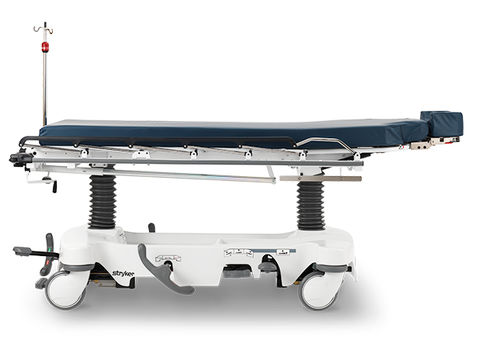Body Mechanics
Mac Medical Stretcher Manual Heal Lift Kit
- The safest and most efficient way to use your body as to prevent injury.
- Lifting and moving
- Reposition before lifting to avoid awkward positions.
- Keep the body stacked and straight. Avoid twists and awkward positions.
- Keep weight as close to the body as possible.
- Never use your back muscles to lift (Use legs, hip, and butt muscles with the abdominal muscles tensed).
- Proper posture: stand and sit with the back straight. The ears, shoulders, and hips are in vertical alignment.
- Kyphosis: slouch. Hunched back.
- Lordosis: swayback. Lumbar deformation causing stomach too anterior and buttocks too posterior.
Commando 2free flash games to play. A busy EMS provider will often lift a heavy stretcher on 10 calls in a shift. Manual or awkward lifting of flexible stretchers, portable stretchers, and stair chairs can also predispose the. GF Health Products, Inc. Is one of the world's leading manufacturers of medical products, with 300 US-based employees, marketing our internationally recognized brands. Future Health Concepts sells new and used, refurbished Hospital Stretchers. Free estimates on Hospital Stretchers and all ACS hospital and urgent care medical equipment.
General Lifting and Moving

- The Power Lift: use of body mechanics. With the back straight, feet apart and abs tensed, lifting is done from the waist down. A firm 'power grip' is used.
- The Power Grip: palms and fingers come in complete contact with the object (gripping, not hooking).
- The Squat Lift: same as power lift but with one foot (the weaker foot) slightly forward.
- One-Handed Carrying Technique: Back straight and locked. Do not lean more than necessary to balance. Use below the waist for lifting.
- Reaching: reach no more than 15-20 inches in front of the body.
- Pushing and Pulling: if possible, always push. Back straight, hands between waist and shoulders.
Emergency Moves
- Characteristics of emergency moves
- Fastest
- No spinal stabilization
- Performed when the scene is not safe, and there is an immediate danger to both the patient and the rescuer.
- The Armpit-Forearm Drag: position behind the patient, reach through and under their armpits, grab their forearms, and then drag.
- The Shirt Drag: fasten the patients' hands or wrists together, and then drag their shirt by the shoulders. Does not work for T-shirts.
- The Blanket Drag: wrap a blanket beneath the patient, and then drag the blanket at the patient's head.
Urgent Moves
- Characteristics of urgent moves
- Fast
- Spinal immobilization
- Performed when the scene is safe, but there is an immediate threat to the patient's life. Common in car accidents.
- Rapid Extrication: Getting a patient out of a car onto a backboard while providing constant spinal immobilization.
Nonurgent Moves
Mac Medical Stretcher Manual Heal Lifting
- Characteristics of nonurgent moves: scene safe, patient stable.
- If possible, and when in doubt, always suspect spinal injury and provide full spinal immobilization onto a backboard before moving. For example, a patient out of a car crash should always be immobilized even if he or she appears well. Use the techniques below only if there is no spinal injury.
- Direct Ground lift: two or more rescuers lifting a patient from the side (the way you would cradle a baby).
- Extremity Lift: two rescuers lifting the patient by the extremities. One rescuer in the armpit-forearm drag position and the other holding the patient behind the knees.
- Direct Carry: similar to the direct ground lift, except that you carry instead of lifting because the patient is not on the ground.
- Draw Sheet: similar to a blanket drag. The rescuers drag sideways the bedsheet beneath the patient so that both the bedsheet and the patient is moved.

Carrying Devices
Mac Medical Stretcher Manual Heal Lifts
- Stretcher: a bed-like device for transportation of patients.
- Wheeled Stretcher: a stretcher with wheels. Commonly seen in the ER, where the patient is pushed around on beds with wheels.
- Portable Stretcher: a light stretcher without wheels.
- Scoop Stretcher: a stretcher that can split apart to scoop up the patient on the ground from either side.
- Basket Stretcher: a stretcher with protective guards around the circumference (like a boat).
- Flexible Stretcher: a stretcher that is flexible and can fold.
- Bariatric Stretcher: a stretcher that can support up to 1600 pounds. For very large patients.
- Stair Chair: a chair with handles to carry a sitting patient.
- Backboard: a hard board used for spinal immobilization. Equipped with hand holds and belts to fasten the patient. Can float in water.
- Full Body Vacuum Mattress: a rigid mattress upon the application of a vacuum. Can provide surface for spinal immobilization.
- KED (Kendrick Extrication Device): a short backboard that provides full spinal immobilization. Can be applied when the patient is in a sitting position.
